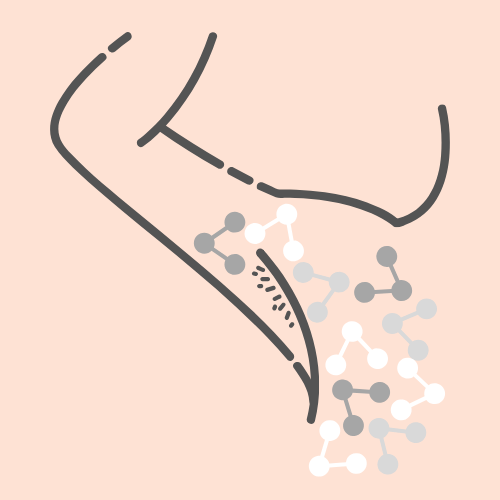The ‘Why’ & ‘How’ of Switching to Natural Deodorant
The hype about switching to natural deodorant is not a fad! It’s a simple, and wise decision to decrease your toxin exposure on a daily basis.
The lymphatic system is a network of vessels in the body responsible for filtering out waste from cells and organs systems, draining fluid accumulation, and fighting infection and precancerous cells. The lymph system is present in nearly every area of your body, but there are 20 lymph nodes in each armpit! Lymph nodes are small pockets of tissue that filter the lymph fluid and contain lymphocytes (white blood cells) that help fight infection and disease.
Most adults apply deodorant or antiperspirant daily to their underarms. Conventional deodorant contains chemicals such as parabens, phthalates, aluminum, triclosan, and propylene glycol. When the local axillary lymph nodes are busy detoxifying from chemical-laden personal care products they may not have the time to fight off infection and other disease as effectively. The toxins found in deodorant and antiperspirants have been linked to a variety of different health concerns and should be avoided.
TOXINS FOUND IN DEODORANT & ANTIPERSPIRANT
Parabens
Parabens are preservatives used in deodorant and other personal care products. Parabens have been shown to mimic estrogen human cells, disrupting the way your body produces and utilizes hormones in the body. A 2004 study found parabens in 18 of 20 breast cancer patients’ breast and tumour tissue. However, the study was not able to prove parabens caused the breast cancer.
Phthalates
Phthalates are found in products with ‘fragrance’. They are known endocrine disrupters and have been linked to obesity, alternated reproductive development, and male fertility issues.
Aluminum
Aluminum is one of the top six most common toxic heavy metals. Aluminum is extremely prevalent in deodorant and antiperspirant. Ironically, symptoms of high levels of aluminum include excessive perspiration, among others like headaches, memory loss, learning difficulties, weak and aching muscles. In the central nervous system (CNS) aluminum inhibits NA-K ATP-ase and hexokinase enzymes in the brain, blocking electrical discharge of nerve cells, thus reducing CNS activity.
Triclosan
Triclosan in formulated into products for its bacteria-killing capacity. When combined with water, triclosan can create the carcinogenic gas chloroform. As a pesticide, triclosan is used to reduce or prevent bacterial contamination. In animal studies, triclosan has been shown to alter hormone regulation. Studies conducted on bacteria suggest that triclosan could contribute to antibiotic-resistant strains of bacteria.
Propylene Glycol
Propylene glycol is a petroleum-based ingredient put in deodorant to have it glide onto the skin easily. However, large quantities of it can damage the CNS, liver, and the heart. The amount of this toxin found in personal care products is minute, but the quantities of this chemical can build up in the body over time with repetitive use. Some companies use vegetable-based propylene glycol, which is an environmentally safer alternative.
MY TOP PICKS FOR NATURAL DEODORANT
Biossance – Squalane + Bamboo Deodorant
Lasts 6-8 hours, no rash or reaction, subtle fresh scent, keeps you dry, leaves white marks on inside of black shirts, apply as a stick deodorant
Routine – Baking Soda Free (Johnny’s Cash)
Lasts 8-10 hours, no rash or reaction, subtle earthy fresh scent, no white marks on shirts, apply with your hands
Farmacy – Freshen Up All-Natural Deodorant
Lasts 8-10 hours, no rash or reaction, subtle fresh scent , apply as a stick deodorant
TROUBLESHOOTING CONCERNS WITH NATURAL DEODORANT
Some of the resistance about switching to natural deodorant comes down to 3 main things. Concerns about natural deodorant:
Body Odour - Is natural deodorant going to work?
Let’s face it, not all natural deodorants work. I have been on the hunt for the best deodorant for a long time and have narrowed down my top picks that actually work!
Try one of my top picks listed above: Biossance, Routine, Lululemon Selfcare
Honorable mentions:
Saje - Exotic Crystal Fresh Deodorant
Agent Nateur - Deodorant holi (stick)
Access - Where can I buy natural deodorant?
Sephora.ca - Online and in store
Well.ca - Online and in store
The Soap Dispensary - located on Main St. in Vancouver. They even offer refills of Routine deodorant if you bring in your old jar when your first jar runs out!
Cost - How much does natural deodorant cost?
Price ranges from $14-$28, and lasts several months.
Additional concerns that come up are usually from people who have tried to make the switch before, but it didn’t work for them:
Baking Soda Rash - Is there baking soda-free natural deodorant?
Read the labels, look for both “baking-soda” and “sodium bicarbonate” as an ingredient to avoid if you know your skin is sensitive, or you have previously got a rash from using natural deodorant.
All suggestions above are baking-soda free.
Read the labels, look for both “baking-soda” and “sodium bicarbonate” as an ingredient to avoid if you know your skin is sensitive, or you have previously got a rash from using natural deodorant.
All suggestions above are baking-soda free.
Detox Reaction - How can I prevent strong body odour when I first make the change?
Ingredients
1 Tbsp bentonite clay, 1 tsp apply cider vinegar, 1-2 tsp of water, 3-5 drops of tea tree essential oil.
Directions
Mix all ingredients together into a smooth paste using a wooden spoon in a glass bowl (avoid using metal).
Use
Use your hands to spread a thin layer of the mask over your armpits. Allow mask to sit for 5-15 minutes, then wash off in the shower or with warm water on a washcloth.
Repeat daily up to two weeks. Discontinue immediately if you develop a rash or irritation other than mild, transient redness.
DIY Deodorant (Baking Soda Free)
Ingredients
1/4 cup arrowroot powder or cornstarch
1/4 bentonite clay
1/2 cup coconut oil
10-15 drops of tea tree and/or lavender essential oil (anti fungal, antibacterial)
5-10 drops of one or a combination of eucalyptus, rosemary, lemon, pine, or peppermint (*use sparingly as it is very cooling)
Directions
Warm coconut oil until soft
Mix all ingredients together until smooth and well-integrated.
Store natural deodorant in a small jar with a lid in a cool location to prevent coconut oil from liquifying.
Use
Apply a small amount of cream deodorant with hands, wash hands after application.
What's your favourite natural deodorant? I'd love to hear in the comments below!
Take care,
Dr. Laura Nicholas, ND
This content is not intended to be substituted or interpreted as medical advice and should not be used to diagnose, treat, or prevent any disease or health concern. Please book a consultation with me or a qualified healthcare professional before acting on any information presented here.


